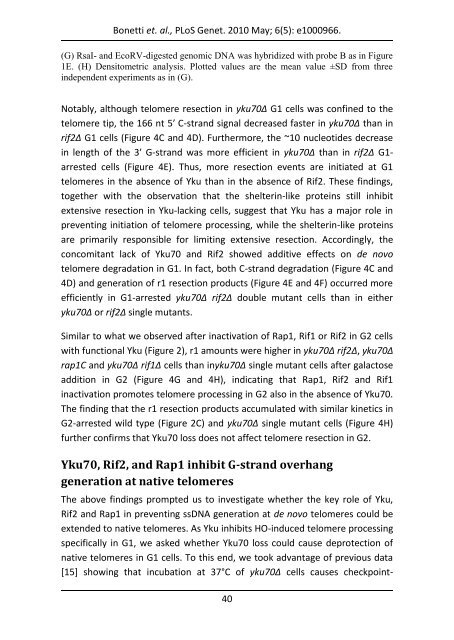View/Open - Università degli Studi di Milano-Bicocca
View/Open - Università degli Studi di Milano-Bicocca
View/Open - Università degli Studi di Milano-Bicocca
You also want an ePaper? Increase the reach of your titles
YUMPU automatically turns print PDFs into web optimized ePapers that Google loves.
Bonetti et. al., PLoS Genet. 2010 May; 6(5): e1000966.<br />
(G) RsaI- and EcoRV-<strong>di</strong>gested genomic DNA was hybri<strong>di</strong>zed with probe B as in Figure<br />
1E. (H) Densitometric analysis. Plotted values are the mean value ±SD from three<br />
independent experiments as in (G).<br />
Notably, although telomere resection in yku70Δ G1 cells was confined to the<br />
telomere tip, the 166 nt 5′ C-strand signal decreased faster in yku70Δ than in<br />
rif2Δ G1 cells (Figure 4C and 4D). Furthermore, the ~10 nucleotides decrease<br />
in length of the 3′ G-strand was more efficient in yku70Δ than in rif2Δ G1arrested<br />
cells (Figure 4E). Thus, more resection events are initiated at G1<br />
telomeres in the absence of Yku than in the absence of Rif2. These fin<strong>di</strong>ngs,<br />
together with the observation that the shelterin-like proteins still inhibit<br />
extensive resection in Yku-lacking cells, suggest that Yku has a major role in<br />
preventing initiation of telomere processing, while the shelterin-like proteins<br />
are primarily responsible for limiting extensive resection. Accor<strong>di</strong>ngly, the<br />
concomitant lack of Yku70 and Rif2 showed ad<strong>di</strong>tive effects on de novo<br />
telomere degradation in G1. In fact, both C-strand degradation (Figure 4C and<br />
4D) and generation of r1 resection products (Figure 4E and 4F) occurred more<br />
efficiently in G1-arrested yku70Δ rif2Δ double mutant cells than in either<br />
yku70Δ or rif2Δ single mutants.<br />
Similar to what we observed after inactivation of Rap1, Rif1 or Rif2 in G2 cells<br />
with functional Yku (Figure 2), r1 amounts were higher in yku70Δ rif2Δ, yku70Δ<br />
rap1C and yku70Δ rif1Δ cells than inyku70Δ single mutant cells after galactose<br />
ad<strong>di</strong>tion in G2 (Figure 4G and 4H), in<strong>di</strong>cating that Rap1, Rif2 and Rif1<br />
inactivation promotes telomere processing in G2 also in the absence of Yku70.<br />
The fin<strong>di</strong>ng that the r1 resection products accumulated with similar kinetics in<br />
G2-arrested wild type (Figure 2C) and yku70Δ single mutant cells (Figure 4H)<br />
further confirms that Yku70 loss does not affect telomere resection in G2.<br />
Yku70, Rif2, and Rap1 inhibit G-strand overhang<br />
generation at native telomeres<br />
The above fin<strong>di</strong>ngs prompted us to investigate whether the key role of Yku,<br />
Rif2 and Rap1 in preventing ssDNA generation at de novo telomeres could be<br />
extended to native telomeres. As Yku inhibits HO-induced telomere processing<br />
specifically in G1, we asked whether Yku70 loss could cause deprotection of<br />
native telomeres in G1 cells. To this end, we took advantage of previous data<br />
[15] showing that incubation at 37°C of yku70Δ cells causes checkpoint-<br />
40

















